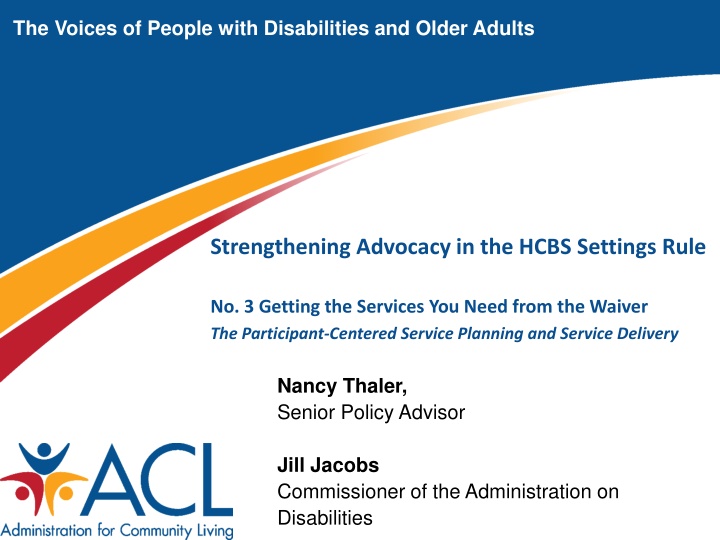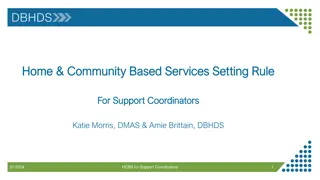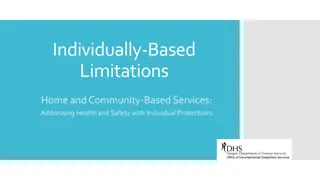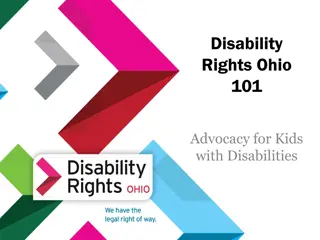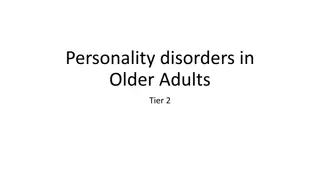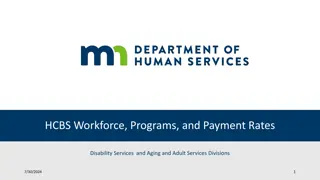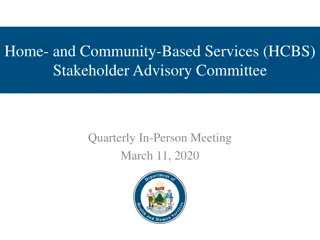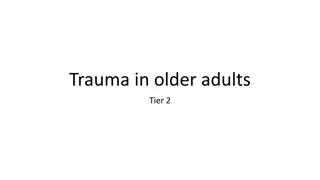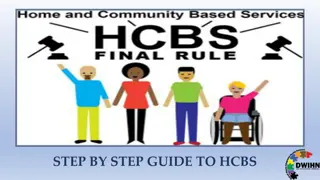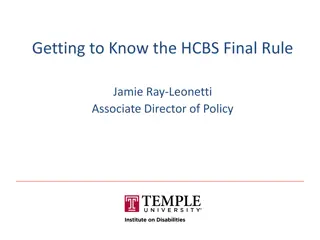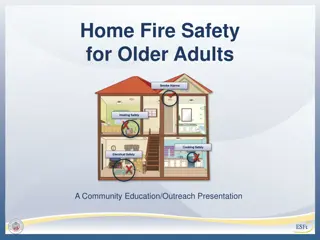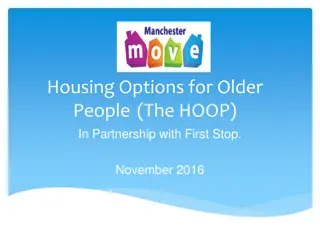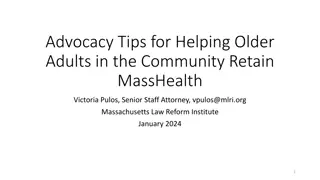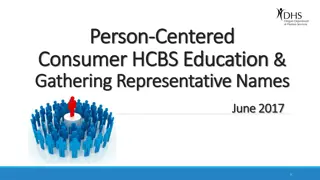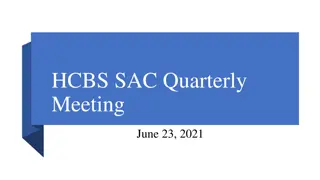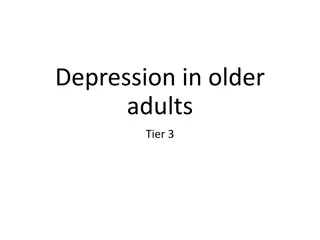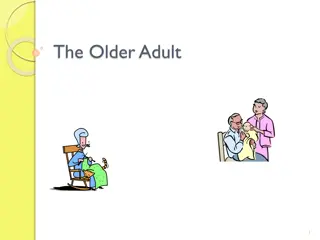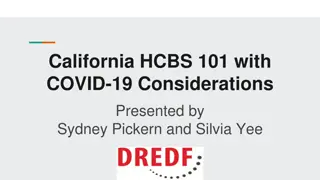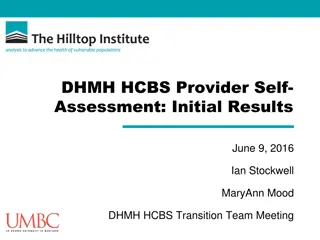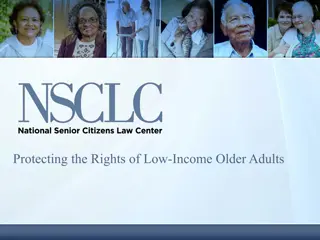Webinar Series: Strengthening HCBS Advocacy for People with Disabilities and Older Adults
Explore the crucial role of stakeholders in ensuring high-quality Home and Community Based Services (HCBS) in the Medicaid Waiver Application process. Dive into aspects such as Participant-Centered Planning, Service Delivery, State Presentations, and more. Understand why the Waiver Application is vital and learn about its components, including Appendix details and the importance of following the HCBS Rule.
Download Presentation

Please find below an Image/Link to download the presentation.
The content on the website is provided AS IS for your information and personal use only. It may not be sold, licensed, or shared on other websites without obtaining consent from the author.If you encounter any issues during the download, it is possible that the publisher has removed the file from their server.
You are allowed to download the files provided on this website for personal or commercial use, subject to the condition that they are used lawfully. All files are the property of their respective owners.
The content on the website is provided AS IS for your information and personal use only. It may not be sold, licensed, or shared on other websites without obtaining consent from the author.
E N D
Presentation Transcript
The Voices of People with Disabilities and Older Adults Strengthening Advocacy in the HCBS Settings Rule No. 3 Getting the Services You Need from the Waiver The Participant-Centered Service Planning and Service Delivery Nancy Thaler, Senior Policy Advisor Jill Jacobs Commissioner of the Administration on Disabilities
Webinar Logistics Participants will be muted during this webinar. You can use the chat feature in Zoom to post questions and communicate with the hosts. Toward the end of the webinar, our speakers will have an opportunity to respond to questions that have been entered into chat. The webinar will be live captioned in English. Live English captions can be accessed by clicking the CC button at the bottom of your Zoom screen. This live webinar includes an evaluation poll at the end of the session. 2
Welcome This is second in the Administration for Community Living s (ACL) Webinar Series on the role of stakeholders in ensuring high quality in Home and Community Based Services (HCBS). In this session we are going to dive into the Medicaid Waiver Application including how components of the HCBS rule can be imbedded in the state s waiver application. 3
Agenda The Medicaid Waiver application an Overview Services - Appendix D Participant-Centered Planning and Service Delivery State presentation Getting the Services I Need from the Waiver Questions and Answers Closing Comments and Evaluation Poll 4
Why the Waiver Application is Important States describe Who and how many people they will serve What services they will provide and how much What protections are in place Whether people can self-direct and family members can be paid How they will follow the HCBS Rule When CMS approves the application, the state must implement it as approved. Only what is in the waiver can be provided. 5
The Waiver Application Basic Information: Identifies level of care Describes geographic limits Describes public input Signature agreeing to meet the assurances. Appendix D Participant-Centered Service Planning Appendix E Participant Direction Appendix F Rights Appendix A Waiver Administration and Operation Appendix G Safeguards Appendix H Quality Appendix B Access and Eligibility Appendix I Financial Accountability Appendix C Services Appendix J Budget Neutrality 6
Why the Waiver Application is Important? The Person-Centered Plan is the only vehicle to assure that Needs are assessed and met Preferences are honored Opportunities are provided Choice is offered Rights are protected Hopes and dreams for a good life can be achieved 7
Person-Centered Service Plan HCBS Regulation Based on the independent assessment required in 441.720, (a) (a) Person Person- -centered planning process centered planning process. Based on the independent assessment the State must develop (or approve, if the plan is developed by others) a written service plan jointly with the individua jointly with the individual (including, for purposes of this paragraph, the individual and the individual's authorized representative if applicable). The person-centered planning process is driven by the individual. The process: a written service plan (1) Includes Includes people chosen by the individual. (2) Provides necessary information and support to ensure that the individual directs the process Provides necessary information and support to ensure that the individual directs the process to the maximum extent possible and is enabled to make informed choices and decisions. (3) Is timely and occurs at times and locations of convenience to the individual. Is timely and occurs at times and locations of convenience to the individual. (4) Reflects cultural considerations of the individual ) Reflects cultural considerations of the individual and is conducted by providing information in plain language and in a manner that is accessible to individuals with disabilities and persons who are limited English proficient, consistent with 435.905(b) of this chapter. (5) Includes strategies for solving conflict or disagreement Includes strategies for solving conflict or disagreement within the process, including clear conflict of interest guidelines for all planning participants. (6) Offers choices to the individual regarding the services and supports the individual receives and Offers choices to the individual regarding the services and supports the individual receives and from whom. from whom. (7) Includes a method for the individual to request updates to the plan Includes a method for the individual to request updates to the plan, as needed. (8) Records the alternative home and community Records the alternative home and community- -based settings that were considered by the individual individual. based settings that were considered by the 8
Person-Centered Service Plan HCBS Regulation (b) The person-centered service plan. The person-centered service plan must reflect the services and supports that are important for the individual to meet the needs supports that are important for the individual to meet the needs identified through an assessment of functional need, as well as what is important to the individual with regard to preferences for the delivery of such services and supports. Commensurate with the level of need of the individual, and the scope of services and supports available under the State plan HCBS benefit, the written plan must: must reflect the services and (1) Reflect that the setting in which the individual resides is chosen by the individual. Reflect that the setting in which the individual resides is chosen by the individual. The State must ensure that the setting chosen by the individual is integrated in and supports full access of individuals receiving Medicaid HCBS to the greater supports full access of individuals receiving Medicaid HCBS to the greater community, including opportunities to seek employment and work in competitive integrated settings, engage in community life, community, including opportunities to seek employment and work in competitive integrated settings, engage in community life, control personal resources, and receive services in the community to the same degree of access as individuals not receiving control personal resources, and receive services in the community to the same degree of access as individuals not receiving Medicaid HCBS. Medicaid HCBS. (2) Reflect the individual's strengths and preferences. Reflect the individual's strengths and preferences. (3) Reflect clinical and support needs Reflect clinical and support needs as identified through an assessment of functional need. (4) Include individually identified goals and desired outcomes. individually identified goals and desired outcomes. (5) Reflect the services and supports (paid and unpaid) that will assist the individual to achieve identified goals, and the prov Reflect the services and supports (paid and unpaid) that will assist the individual to achieve identified goals, and the provide of those services and supports, including natural supports. of those services and supports, including natural supports. Natural supports are unpaid supports that are provided voluntarily to the individual in lieu of State plan HCBS. (6) Reflect risk factors and measures in place to minimize them Reflect risk factors and measures in place to minimize them, including individualized backup plans and strategies when needed. (7) Be understandable to the individual receiving services and supports, and the individuals important in supporting him or her. At a minimum, for the written plan to be understandable, it must be written in plain language and in a manner that is accessible for the written plan to be understandable, it must be written in plain language and in a manner that is accessible to individuals to individuals with disabilities and persons who are limited English proficient, consistent with 435.905(b) of this chapter. (8) Identify the individual and/or entity responsible for monitoring the plan. Identify the individual and/or entity responsible for monitoring the plan. (9) Be finalized and agreed to, with the informed consent of the individual in writing, informed consent of the individual in writing, and signed by all individuals and providers responsible for its implementation. (10) Be distributed to the individual Be distributed to the individual and other people involved in the plan. (11) Include those services, the purchase or control of which the individual elects to self Include those services, the purchase or control of which the individual elects to self- -direct, 441.740. (12) Prevent the provision of unnecessary or inappropriate services and supports. iders rs direct, meeting the requirements of 9
Person-Centered Service Plan: HCBS Regulation (13) Document that any modification of the additional conditions Document that any modification of the additional conditions, under 441.710(a)(1)(vi)(A) through (D) of this chapter, must be supported by a specific assessed need and justified in the must be supported by a specific assessed need and justified in the person person- -centered service plan. centered service plan. The following requirements must be documented in the person- centered service plan: (i) Identify a specific and individualized assessed need. (ii) Document the positive interventions and supports used prior to any modifications to the person-centered service plan. (iii) Document less intrusive methods of meeting the need that have been tried but did not work. (iv) Include a clear description of the condition that is directly proportionate to the specific assessed need. (v) Include a regular collection and review of data to measure the ongoing effectiveness of the modification. (vi) Include established time limits for periodic reviews to determine if the modification is still necessary or can be terminated. (vii) Include informed consent of the individual; and (viii) Include an assurance that the interventions and supports will cause no harm to the individual. (c) Reviewing the person-centered service plan. The person and revised upon reassessment of functional need as required in and revised upon reassessment of functional need as required in 441.720, at least every 12 months, when the individual's circumstances or needs change significantly, and at the request of the months, when the individual's circumstances or needs change significantly, and at the request of the individual. individual. The person- -centered service plan must be reviewed centered service plan must be reviewed 441.720, at least every 12 10
Service Plan Development Appendix D - 1 a) Who Does the Plan b) Safeguard for Conflict of Interest c) Supports for the Person to Direct the Plan 11
Service Plan Development Appendix D - 1 a. Who Does the Plan Registered Nurse LPN or Voc. Nurse Physician MD or DO Case Manager specify qualifications Social Worker - specify qualifications Other - specify qualifications 12
Service Plan Development Appendix D - 1 b. Conflict of Interest Safeguards 13
Service Plan Development Appendix D - 1 c. Supporting the Participant in Plan Development Specify the supports and information that are made available to the person 14
Service Plan Development Appendix D - 1 d. Service Plan Development Who develops the plan Who participates Timing of the plan Types of assessment How the person is informed of available services How goals, needs and preferences are addressed How services are coordinated How responsibilities to implement and monitor are assigned When is the plan updated 15
Service Plan Development Appendix D - 1 e, f, g 16
Service Plan Development Appendix D - 1 h and i 17
Service Plan Development Appendix D 2 Service Plan Implementation and Monitoring 18
Provider Role Participate in the planning process if designated by the person Along with the case manager, support the person to participate Discussing the process ahead of time Assuring accommodations are in place Implement that plan Develop a provider level plan with specifics on implementation Translate the PCP into everyday guidance for direct care staff Maintain a record of implementation 19
Colorado Person-Centered Assessment and Support Plan Effort covers eligibility determination, needs assessment and service/support plan When did it start Stakeholder engagement Assures that all pieces are person centered and avoids asking people the same questions over and over/telling their story repeatedly HCBS Rule Requirements included in Colorado s PCSP Needs Assessed and services linked to them Personal Goals and Preferences and services linked to them Documenting choice Quality of life things like identifying who is important and how to see them; recording what people like to do Employment and Community Integration 20
Colorado Single Assessment & PCSP Background Development began in 2016 with the passage of legislation (SB 16-192) requiring a single, statewide assessment for Medicaid LTSS to replace the more than 30 tools that were in use The Department undertook an extensive stakeholder engagement process (~6 years) to develop a comprehensive, person-centered assessment and support planning process The process will include (estimated implementation July 2023): Streamlined eligibility determination Level of Care (LOC) Screen Needs Assessment Person-Centered Support Plan The new processes are all housed within a brand-new Care and Case Management IT system to streamline and automate the process 21
Colorado Person-Centered Assessment & Support Plan The people who do the plan case managers Conflict free and why (CMRD) Ratio in caseloads 65:1 per RFP & Rate Structure Training, training, training What do providers do with the Person-Centered Support Plan They must have it and know it (sign that they agree to follow it, as the contract for services with the Member) They write a service plan that staff can follow on a daily basis How does the state know this is working on an ongoing basis - oversight 22
Colorado Single Assessment & PCSP How It works The new CSA will be used for all populations and all HCBS waivers in CO The process is designed using modules, so members can work with their case managers on only the required items needed to move forward or delve deep in some or all areas, making the process person-centered by design 23
All modules can be found on the website under Assessment Tools at: hcpf.colorado.gov/new- assessment-and-person-centered-support-plan 24
https://hcpf.colorado.gov/sites/hcpf/files/Support% 20Plan-October%202020.pdf 25
https://hcpf.colorado.gov/sites/hcpf/files/Support% 20Plan-October%202020.pdf 26
https://hcpf.colorado.gov/sites/hcpf/files/Support% 20Plan-October%202020.pdf 28
https://hcpf.colorado.gov/sites/hcpf/files/Support% 20Plan-October%202020.pdf 29
Colorado Single Assessment & PCSP The People Members Case Managers Providers Member handbook and training to help navigate the process Decide how much of the assessment to go through (outside the required items) Can invite anyone to participate in the process Members decide where the CSA & PCSP are conducted Will have direct access to their own Member record through a Mobile application Case managers at Case Management Agencies contracted with the Department conduct the process New, comprehensive training for all case managers, including person-centeredness Required to demonstrate competency before conducting CSA New IT system to support the process and ongoing case management Receive a copy of the person-centered support plan Providers must sign agreement with the decision made by Members for services they will provide 30
Colorado Single Assessment & PCSP Oversight and Accountability Case managers are required to demonstrate competency with the new CSA process (WBTs, VILTs, competency tests in the LMS system) Spot checks for Inter-Rater Reliability Department Quality Performance Unit reviews (QIS PMs) 31
https://hcpf.colorado.gov/sites/hcpf/files/Support% 20Plan-October%202020.pdf 32
https://hcpf.colorado.gov/sites/hcpf/files/Support% 20Plan-October%202020.pdf 33
https://hcpf.colorado.gov/sites/hcpf/files/Support% 20Plan-October%202020.pdf 34
Why is the Waiver Application Important? The Person-Centered Plan is the only vehicle to assure that Needs are assessed and met Preferences are honored Opportunities are provided Choice is offered Rights are protected Hopes and dreams for a good life can be achieved 35
How You Can Influence What Services are in the Waiver Get copies of the proposed application and distribute it to others Hold discussion sessions about the proposed services as compared to what people need Show up in person and give public comment ask questions Ask for a meeting with the state agency to learn more about the application Submit written comments from your organization Coordinate templates for others to use in submitting comments Consult partners about submitting join comments 36
State Waiver Applications Access proposed and approved waivers for all states at https://www.medicaid.gov/medicaid/section-1115-demo/demonstration-and-waiver- list/index.html?f%5B0%5D=waiver_state_facet%3A991#content#content Access the application form, technical guide and other related materials at CMS Waiver Applications Portal: https://www.medicaid.gov/medicaid/home-community-based-services/home-community- based-services-authorities/home-community-based-services-1915c/index.html Click on 1915(c) Waiver Application in the box on the right On the left click on 1915(c) Application download version. Will download as a zip file. 37
Please put any questions in the chat and give us your honest feedback in the on-screen poll. Thank you. 38
